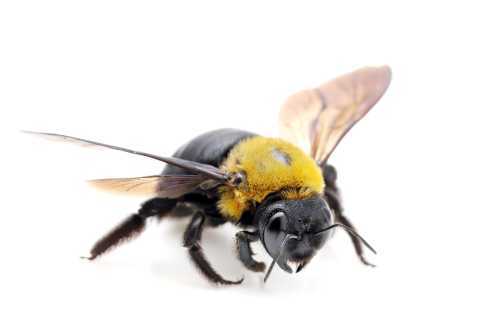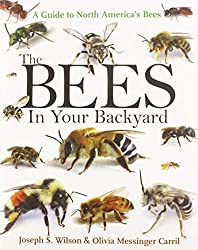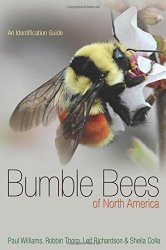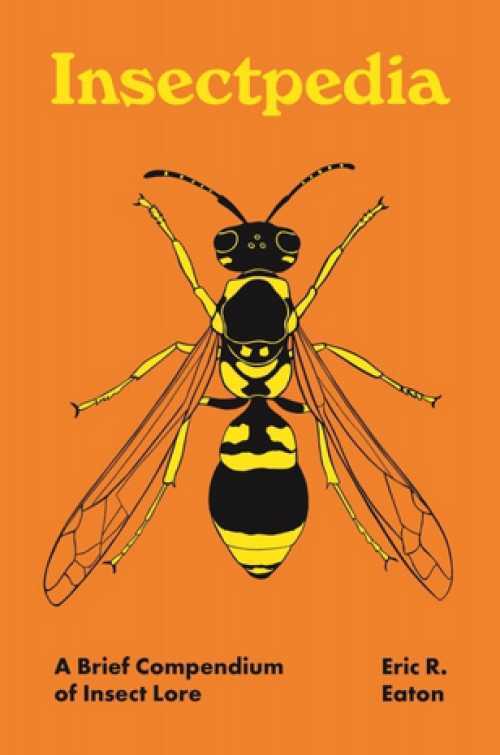Eastern Carpenter Bee - Xylocopa virginica
Sometimes confused with bumble bee species, the eastern carpenter bee (Xylocopa virginica) is a large, burly bee, renowned for its ability to chew and tunnel into wood, as well as provide a useful pollination service. Here, we'll look at what scientific study tells us about this interesting bee species.
About The Eastern Carpenter Bee - Xylocopa virginica
The eastern carpenter bee (Xylocopa virginica) is established throughout eastern North America (from Southern Canada to Florida and Texas, and extending into the mid-west). It has also been found as far west as Colorado4.
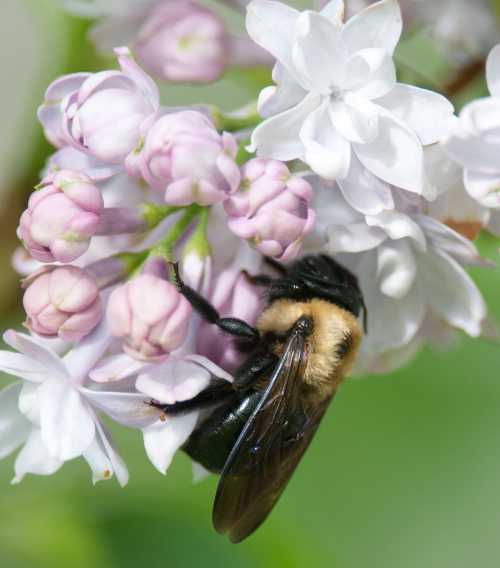 Eastern Carpenter Bee - Xylocopa virginica - female
Eastern Carpenter Bee - Xylocopa virginica - femaleNesting habits of Xylocopa virginica
Eastern carpenter bees make nests in exactly the same way as other carpenter bees, but will nest either in groups or as a solitary bee5.
It is thought that this behavior is dependent on the availability of nest sites and materials, and climactic conditions – so if nesting resources are readily available, then the eastern carpenter bee queens seem to prefer to nest as solitary bees, whereas, if nesting resources are less abundant, they will nest as groups4.
The behavior of eastern carpenter bees in nests is quite different from honey bees and bumble bees. Honey bee and bumble bee nests have one female that mates and lays eggs (the queen), with all the other worker females caring for the queen, the brood, and the nest.
In social eastern carpenter bee nests, however, all female bees can mate and produce offspring, although it does seem that there is usually just one female (often referred to as the ‘primary female’) that produces young and forages to feed the offspring and the other female bees, while the rest of the females care for and protect the nest4,5.
The death of a ‘primary female’ will lead to supersedure – wherein a ’secondary female’ will take the place of the deceased ‘primary female’5.
Social nests contain 2 – 5 adult female bees, but social nests do not generate more brood than solitary nests5. Males are territorial – especially around the nest - seeking to protect the nest and find mating opportunities.
It has been observed that eastern carpenter bees’ abandoned nests are sometimes occupied by female giant resin bees (Megachile sculpturalis)1,2,3 . The resin bees do this because they can’t excavate holes in wood themselves, so they occupy pre-existing, but abandoned nests.
Appearance
Eastern carpenter bees have an abdomen that is mostly glossy black, with a slight metallic tint6. The thorax is covered in pale ginger hair.
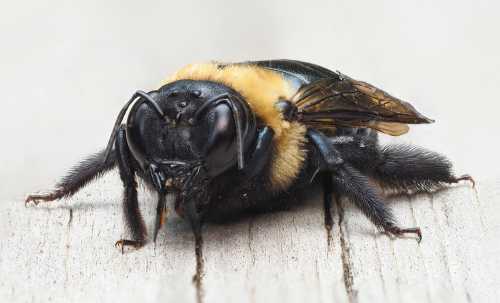 Female eastern carpenter bee showing black face
Female eastern carpenter bee showing black faceFemales have black faces, whereas males can easily be distinguished from females due to their white faces. It is also known that males have a larger thoracic volume than females7.
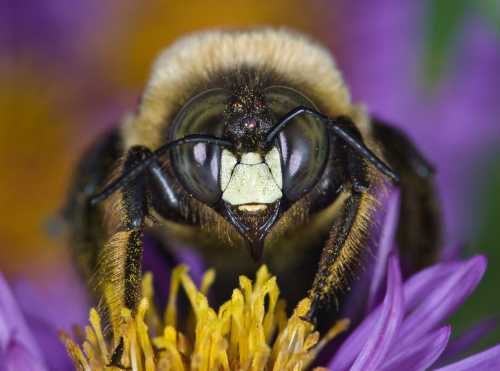 Male eastern carpenter bee showing white face
Male eastern carpenter bee showing white face
It seems to
be possible to distinguish the social order of females of eastern carpenter bee
based on the amount of wear and tear of the mandibles (jaws) and the wings:
primary females tend to have more wear of mandibles and visible wing damage
than secondary or tertiary females, because they carry out more foraging and
nesting behaviors8.
Additionally, primary females are larger than the other females8.
This excellent piece of short video footage captures three points of interest to look out for:
- a male and a female, with the white face of the male clearly visible.
- foraging behavior - in particular, nectar robbing small, bell-shaped Pieris flowers. However, a further video is provided later in this article, clearly demonstrating legitimate foraging and the prowess of this species as an excellent pollinator.
- a male pouncing on the female to mate.
The bumble bee, Bombus impatiens is similar in appearance to the eastern carpenter bee, but the abdomen is visibly more hairy.
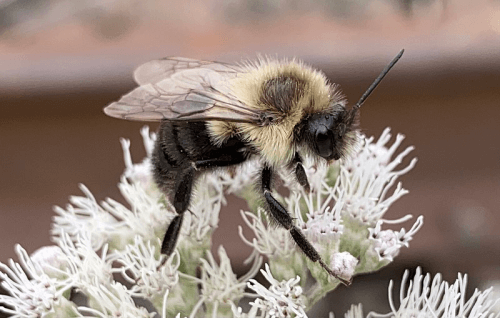 The common eastern bumble bee, Bombus impatiens is similar in appearance to the eastern carpenter bee, but the abdomen is more hairy.
The common eastern bumble bee, Bombus impatiens is similar in appearance to the eastern carpenter bee, but the abdomen is more hairy.
Eastern carpenter bees belong to the Apidae bee family, and are categorized as having long tongues.
Eastern carpenter bee foraging preferences
For food, the eastern carpenter bee relies on pollen and nectar. They are polylectic11 (they will visit a wide range of flowering plants).
As noted from the above video, they are (like many bee species) adept at nectar robbing – a behavior reported in eastern carpenter bees as long ago as 1875 by Gentry9.
Pollination service
There is some debate as to whether the eastern carpenter bee is a friend or a pest, and which is most prominent: their pollination role (and ability to buzz pollinate) or their destructive effect on man-made wooden structures.
It does seem, however, that their effect on man-made structures is rather limited. According to Williams and Winifree10 (Bryn Mawr College and Rutgers University):
“Although carpenter bees are often considered pests, they are effective pollinators. Their nesting rarely impacts wood’s structural integrity, but providing them with other sources of wood may keep them from nesting in or near your home.”
They are also know to pollinate a number of important crops8.
The short video below provides evidence of female eastern carpenter bees pollinating passion flower, Passiflora incarnata. As the video continues, each female becomes increasingly covered in pollen grains, particularly on the head and thorax.
Note how the very hairy rear legs of this species are also well adapted to collect pollen.
It is notable by the 'ragged' appearance of the wings and thorax these females are clearly ‘primary females’.
References
- Parys K.A. et al, The Giant Resin Bee, Megachile sculpturalis Smith: New Distributional Records for the Mid- and Gulf-south USA. Biodiversity Data Journal 3:e6733.
- Batra S (1998), Biology of the giant resin bee, Megachile sculpturalis Smith, a conspicuous new immigrant in Maryland. Maryland Naturalist 42: 1-3.
- Magnum & Brooks (1997), First records of Megachile (Callomegachile) sculpturalis Smith (Hymenoptera: Megachilidae) in the Continental United States. Journal of the Kansas Entomological Society 70: 140‑142.
- Anton & Grozinger, Penn State University: extension.psu.edu/the-eastern-carpenter-bee-beneficial-pollinator-or-unwelcome-houseguest
- Richards MH Journal of Insect Behavior 24(5):399-411 (2011) DOI:10.1007/s10905-011-9265-9
- Grissell et al, Large Carpenter Bees, Xylocopa spp. (Insecta: Hymenoptera: Apidae: Xylocopinae)
- Skandalis et al (2009, Body Size and Shape of the Large Carpenter Bee, Xylocopa virginica (L.) (Hymenoptera: Apidae). Journal of the Kansas Entomological Society. 82 (1): 30–42. doi:10.2317/JKES711.05.1.
- Gerling & Hermann (1978), Biology and mating behavior of Xylocopa virginica L. (Hymenoptera, Anthophoridae). Behavioral Ecology and Sociobiology. 3 (2): 99–111. doi:10.1007/BF00294984
- Gentry, T. G. 1875. The fertilization of certain flowers through insect agency. Amer. Nat. 9: 263-7.
- New Jersey Agricultural Extension Service. "Native bee benefits" Rutgers University.
- Field Guide to Bees Of Great Britain And Ireland by Steven Falk.
If you found this page helpful or interesting, I'd really be grateful if you would share it with others - if not this page, perhaps another, such as Gardening For Bees.
Thank you so much :) .
